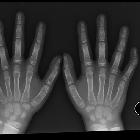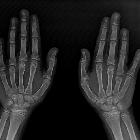clinodactyly









Clinodactyly is a descriptive term that refers to a radial angulation at an interphalangeal joint in the radio-ulnar or palmar planes. It typically affects the 5 finger.
Epidemiology
The estimated incidence is highly variable dependent on sampling and has been reported to range between 1-18%.
Pathology
Clinodactly can result from vast number pathologies ranging from congenital to acquired.
Genetics
As well as being sporadic, it can run in families with an autosomal recessive inheritance.
Associations
Although clinodactyly is often an isolated phenomenon and can be even a normal variant, there are numerous described associations which include:
- aneuploidic syndromic
- Down syndrome: may be seen in up to 60% of infants with Down syndrome
- Klinefelter syndrome
- trisomy 18
- Turner syndrome
- non aneupliodic syndromic
- non syndromic
Significance
Due to its association with chromosomal anomalies, it is considered by some authorities as a "soft sign" if detected in an antenatal ultrasound scan .
Prognosis
If detected in isolation it carries an excellent prognosis.
See also
Siehe auch:
- Down-Syndrom
- Brachydaktylie
- Turner-Syndrom
- Trisomie 18
- macrodystrophia lipomatosa
- Roberts-Syndrom
- Cornelia-de-Lange-Syndrom
- Fanconi-Anämie
- Klinefelter-Syndrom
- Feingold syndrome
- Russell-Silver syndrome
- Kirner's deformity
- Mutchinick-Syndrom
und weiter:
- obstetric curriculum
- Meckel-Syndrom
- kongenitale Anomalien der Finger
- Rubinstein-Taybi-Syndrom
- Akrorenales Syndrom
- Kabuki-Syndrom
- dysencephalia spanchnocystica
- Stenose der Apertura piriformis
- Russell-Silver dwarfism
- Polysyndaktylie
- soft antenatal markers on ultrasound
- Kirner deformity
- SHORT syndrome
- Catel-Manzke-Syndrom
- Pseudoaminopterin-Syndrom

 Assoziationen und Differentialdiagnosen zu Klinodaktylie:
Assoziationen und Differentialdiagnosen zu Klinodaktylie:







